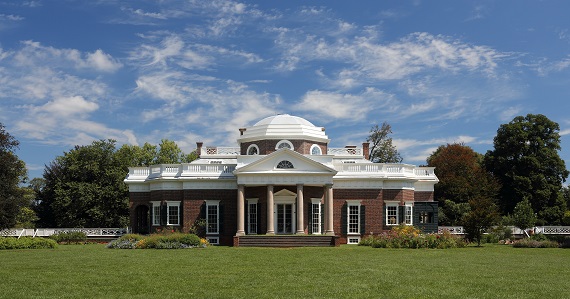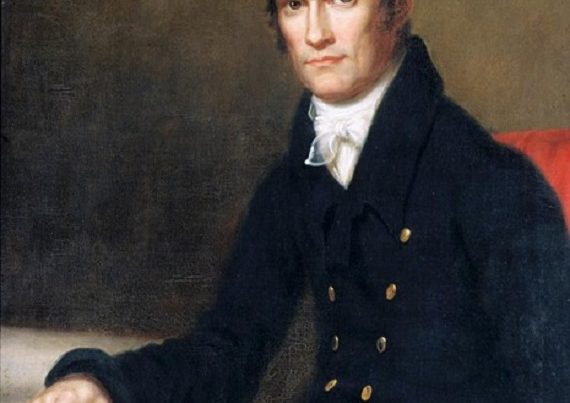The epistolary exchange between Thomas Jefferson and Randolph Jefferson, younger by 12 years and acknowledged by almost all historians to be cognitively challenged, is sparse. It begins during Jefferson’s last year in Paris, 1789. Thomas begins the letter thus, “The occurrences of this part of the globe are of a nature to interest you so little that I have never made them the subject of a letter to you.” There are three letters from 1789 to 1792, each written by Thomas, and the correspondence surceases for some reason till 1807, when Thomas, now president, resumes the correspondence.
With Thomas Jefferson participating in events with global implications, there is nary a letter to Randolph to share his thoughts on those events. Why is Thomas so silent about his extraordinary experiences, especially during his presidency?
The answer is in the first sentence of the first known letter between the two. Randolph has no interest in such matters, because all of his energy is focused on managing Snowden—for him, a task Herculean. Moreover, Thomas is involved in so many significant tasks that letters of business take precedence over letters to family and friends. Consequently, it is in vain for Thomas to write to his brother.
Yet all historians admit large dependency of Randolph on Thomas’ succor for running his plantation, Snowden, 20 miles to the south of Monticello. Still, there is not one letter from Randolph to Thomas till summer 1807. If Randolph is so dependent on his older brother apropos of managing his plantation—and all Jeffersonian biographers concede that—why are there no letters from 1792 to 1807?
The answer can only be that Randolph visits Thomas at Monticello quite often to glean, in person, advice, whenever Thomas retreats from Washington.
That, however, is an answer that the folks at the Thomas Jefferson Foundation (TJF) find abhorrent. Following the argumentum ad ignoratiam—there is no evidence for x, so ~x is the case—they argue merely that absence of evidence is evidence of absence: So long as there is no written evidence of any visits of Randolph to Monticello, we must conclude that there were no visits. They write:
There is no surviving correspondence between the brothers from 1792 to 1807. Thomas Jefferson’s two surviving letters of 1807, which express the hope that his brother would visit Monticello during his spring and late summer vacations, suggest that similar invitations were extended in the preceding years. The correspondence also suggests that Randolph Jefferson may not always have acted on these invitations. In his post-1807 letters, ill health, the poor state of the roads, and other circumstances were often cited as reasons to postpone his Monticello visits. In fact, his only recorded Monticello visits in this period were made on his own business and not at his brother’s invitation.
The obvious reason that the argument is fallacious is that lack of evidence for x cannot be taken as evidence for ~x.
TJF has an agenda. The business of the TJF is to debunk, using whatever means they have at their disposal, the hypothesis that Randolph Jefferson fathered the children of Sally Hemings. They continue:
Only four recorded visits to Monticello (in September 1802, September 1805, May 1808, and sometime in 1814) are known, none related to Sally Hemings’s conceptions. In August 1807, a probable conception time for Eston Hemings, Thomas Jefferson wrote his brother that “we shall be happy to see you also” at Monticello, where Randolph’s twin sister, Anna Marks, was then visiting. A search of visitors’ accounts, memorandum books, and Jefferson’s published and unpublished correspondence provided no indication that Randolph did, in fact, come at this time. A similar search was made of the probable conception time for Madison Hemings, without finding reference to a Randolph Jefferson visit.[1]
When we work our way through the argument, we feel persuaded. Yet something is amiss—greatly amiss.
All persons—even Joanne Yeck, author of a 400-page biography of Randolph Jefferson—who write about Randolph Jefferson acknowledge great reliance on brother Thomas to run well his estate. Let us refer to Thomas’ own account of Randolph’s ability to manage his affairs in the deposition after Randolph’s death: “That he [Thomas] considered his said brother as not possessing skill for the judicious management of his affairs, and that in all the occasions of life a diffidence in his own opinions, an extreme facility and kindness of temper, and an easy pliancy to the wishes and urgency of others made him very susceptible of influence from those who had any views upon him.” It is inconceivable that Randolph during the years 1792 to 1807 would not often have visited his brother—and records of Thomas indicate numerous trips to Monticello during that span—especially given lack of any correspondence. So great is TJF’s investment in Thomas Jefferson as the father of all of Sally Hemings’ children that they aim to block even the possibility of Randolph’s paternity of Sally Hemings’ children. Hence, there is astonishingly no mention of the relationship of the brothers in their entree “Randolph Jefferson.”[2] Their harefooted and shoddy dismissal of other possible Jeffersonian candidates for paternity of Hemings’ children—there are numerous other possibilities consistent with the one 1998 DNA finding of an offspring of Eston Hemings (e.g., some of Randolph’s children and perhaps Peter Carr)—is skullduggery. Their logic is pretzel; their method is cherry-picking. Moreover, they refuse to consider the possibility that Sally Hemings had more than one lover. We know that her mother had four paramours, both black and white.
It is more than strange that they appeal to an argumentative form, fallacious, to bolster their case for Thomas’ paternity, but refuse to appeal to that argument in other instances, when it fails to fit their needs. I cite two instances: lack of correspondence between Thomas Jefferson and Sally Hemings is not taken as evidence of no relationship and lack of any witnesses to any intimacy between Jefferson and Hemings is not evidence of there having been no intimacy. In the first case, they maintain that any letters would necessarily have been destroyed. In the second case, they maintain that Jefferson and Hemings were excellent at dissimulation and secrecy over a period of 38 years!
Absence of evidence for the occurrence of something is, of course, probatively unavailing, but there are instances when absence of evidence is suggestive, even strongly so. Lack of an epistolary exchange between Thomas and Randolph between 1792 and 1807 strongly intimates that Randolph paid numerous visits to see Thomas at Monticello during that span for help with his plantation and financial matters. Excepting the silence of TJF about their relationship, all historians, I reiterate, acknowledge Randolph’s essential dependency on Thomas. If we couple that with Slave Isaac Jefferson’s admission in his memoirs that Randolph was often seen among the slaves to be fiddling and dancing—“Old Masser’s [Thomas’] brother, Mass Randall, was a mighty simple man: used to come out among black people, play the fiddle and dance half the night; hadn’t much more sense than Isaac”[3]—Randolph might easily have enjoyed the added perk of intimacy with toothsome Sally Hemings during those visits. Hemings had children in 1795, 1798, 1799, 1801, 1805, and finally, 1808. After 1808, Hemings has no more children. Randolph’s first wife dies around 1800 and he remarries in 1809. He could readily have been the father of Hemings’ last three children, and there is nothing that shows he could not have fathered the first three. We cannot, like the TJF, rule that out by fiat, by decree. Moreover, there is, I ingeminate, no reason to rule out multiple fathers.
In sum, the DNA study of 1998 makes Randolph a candidate of paternity of Hemings’ last child, Eston (b. 1808)—it is consistent with any male-line Jefferson, having the Jeffersonian Y-chromosome as father—and then there is the testimony of Isaac Jefferson. There is nothing linking Thomas to the slaves of Mulberry Row. There is also nothing known biologically about Eston’s siblings. TJF merely and flatly posits that Thomas Jefferson, and only Thomas Jefferson, was the father of Sally Hemings’ children. To get to that conclusion, which they since 2018 have called factual, they posit that Hemings was monogamous, and they again use argumentum ad ignorantiam: There is no evidence of any other father of any of Hemings’ children, so there is no other father than Thomas. One readily remonstrates that there is nothing tying Thomas to Hemings other than one DNA sample, which does not single out Thomas and makes Randoph (and other male-line Jeffersons) a possible father.
With a paucity of evidence to determine the issue of paternity of Hemings’ children and no eyewitness testimony that links Thomas to Hemings—such things are facts!—all that we can conclude is that we do not know about the father(s) of Hemings’ children. It is bewildering, and scholarly irresponsible, that TJF treats Thomas’ paternity as fact.[4] Yet theirs is a political, not a veridical, agenda. It is about idolizing and sanctifying someone who was historically insignificant, and most likely illiterate—Sally Hemings—and of course, it does not hurt if you can draw in tens of thousands of “Benjamins” along the way. It is astonishing how these “civil-rights” campaigns wind up being so lucrative and that none of the persons benefiting monetarily ever give a though to funneling lucre those oppressed.
We may never know the truth about the paternity of Sally Hemings’ children—there is a DNA sample only from one of Eston Hemings’ descendants and that is not conclusive—but slave Isaac Jefferson’s eyewitness testimony often places Randolph at Mulberry Hill, where the majority of Monticello’s slaves lived. That makes Randolph the most likely candidate for paternity of Eston Hemings, though it is far from conclusive.
I, thus, offer the tantalizing hypothesis that after the death of his wife, Anne, Randolph not only came to Monticello as often as he could for advice on husbandry and fiscal matters, whenever Jefferson returned from Washington, he also on such occasions enjoyed the amorous companionship of Hemings and she was always there when Randolph arrived. How do I know that? After all, following the reasoning of TJF, there is no evidence that Hemings was not there, so she must have been there.
*********************************
[1] Thomas Jefferson Foundation, “Appendix J: The Possible Paternity of Other Jeffersons, A Summary of Research,” https://www.monticello.org/thomas-jefferson/jefferson-slavery/thomas-jefferson-and-sally-hemings-a-brief-account/research-report-on-jefferson-and-hemings/appendix-j-the-possible-paternity-of-other-jeffersons-a-summary-of-research/, accessed 6 Aug. 2023.
[2] Editors, “Randolph Jefferson,” Monticello, https://www.monticello.org/research-education/thomas-jefferson-encyclopedia/randolph-jefferson, accessed 8 Aug. 2023.
[3] Isaac Jefferson, “Memoirs,” Jefferson at Monticello, ed. James A. Bear, Jr. (Charlottesville: University Press of Virginia, 1967), 22.
[4] Their “The Life of Sally Hemings” begins, “Like countless enslaved women, Sally Hemings bore children fathered by her owner.” Editors, “The Life of Sally Hemings,” Monticello, https://www.monticello.org/sallyhemings, accessed 8 Aug. 2023.







Seems a pretty simple and reasonable explanation that no written letters were necessary when Randolph’s visits to his brother merely 20 miles away would allow face to face conversations instead. That such visits would also allow a self-indulgent fraternizing with the help as noted by Isaac would only seem to make the frequency of such visits more likely and believable.
RJ was mentally slow, as evidenced by his letters to TJ. I have a book soon out on their correspondence, with commentary.
with tj’s brother only 20 miles away, would monticello even have to keep a sign in book on the president’s brother? and could Randolph visit monticello while thomas was in dc if he wished? any restrictions on randolph going there? kegger at thomas’s place while he’s away?
TJ did brew his own ale….
We need to grasp that it was a long, anfractuous 20 miles that would take most of the day on most occasions. That acknowledged, I still maintain that RJ very often availed himself of TJ’s succor by frequent trips to MC.
It’s amazing how we can’t understand how different life was in those days. Try going anywhere at 5 miles per hour…
This website says Anne Lewis Jefferson (Randolph’s first wife) died in 1792, which if true would make Randolph even more likely to have been the father of Sally’s children: https://www.geni.com/people/Anne-Jefferson/6000000003615495340